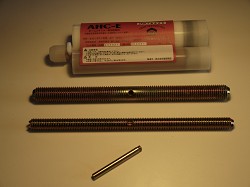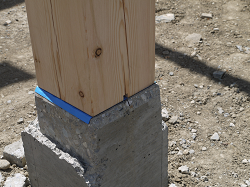Epoxy post anchor system: the best so far
From Daizen News October 2012
We work on many projects, so we receive lots of connection specs from many engineers. It seems like the post anchor connection is still a grey zone in terms of best practices.
This year, we’ve used epoxy anchor connections for almost all of our frames. Why? I think it’s because epoxy anchors lived up to all we thought they would be in their reasonable cost, ease of use, and reliability.
In most steel plate connections, the plates need to be embedded. Plates designed to be attached after the raising still need to be specially fabricated. We often get a phone call after the contractor has installed the frame: “Can you send me detailed information on the connections?” Strangely, we expect to get this information from the contractor! Clearly, there is clearly no generally-accepted standard connection for post anchors, so we have decided to provide a solution for it.
To see this YouTube video of the epoxy connection being assembled, click the image or this link—epoxy video.
When we see the new-building details for post anchors specified with expensive knife plates, we know it means lots of work to set them in place and prepare the timber slot for the plate, which in turn means much greater cost and lots of communication. If we knew who designed this, we could send them information in advance about what we’ve found works better. The epoxy system we favor is much easier to handle.
I explain it to engineers like this. “The epoxy connection is just like a threaded rod cured with epoxy in concrete and wood, except the engineer doesn’t need to worry about whether epoxy will fill properly, because our preferred system is designed to do that.”
Epoxy is injected into threaded rods.
The cavity fills from the middle.
I instruct the job supervisor as follows: “On the concrete that will support the post, find the spot that will be the center of each post, and drill a 6-in.-deep hole there, making sure no rebar is placed in that area. We will provide the rods. Please make sure to insert them with the injection nose accessible for filling the epoxy in once the frame is built.
“Regular concrete epoxy starts to cure in about 5 minutes, so each post needs to be stabilized in its final position for this time. With our system, you don’t need to hold each post in a definite position for 5 minutes. It allows the entire frame to be raised first. You can adjust the post locations, plumb them, and then inject the epoxy, which will set in place.
“The threaded rod is hollow; the injection nozzle plugs into it halfway down its length. The epoxy will flow out from the end of the rod, so when we see any excess from the injection hole, we know the entire space is filled.”
Setup for injecting the epoxy. Note the small hole at the bottom of the timber.
The epoxy is injected into the hole. When epoxy oozes out, the cavity is full.
To summarize, here are the advantages of this system.
- It requires no steel fabrication.
It does not require any preparation in the concrete, except to make sure the center of the post location is rebar-free.
The epoxy doesn’t need to be filled while building is happening; you inject the epoxy once all adjustments are complete and you’re ready to secure the post.
There is no distributor in North America for this epoxy system, so we carry the stock. For further details, please email us.
Interested in finding out more?
At Daizen, we ensure client expectations and understanding of processes are met through all phases of our work, from structural design and engineering to fabrication of timber frames and assembly and installation.




